#ukraine top exports
Explore tagged Tumblr posts
Text
Discover the major exports of Ukraine and its key export partners with Seair Exim Solutions. Gain insights into Ukraine's export market, trade statistics, and economic impact.
#exports of Ukraine#major export of Ukraine#hs code ukraine#Ukraine export products#Ukraine trade data#Ukraine export data#main export of Ukraine#ukraine top exports#Ukraine biggest export#Ukraine export by country#ukraine import export data
0 notes
Text
Dark fleets and Sanctions
We now have two worlds of international commerce, as a result of trade wars and the Ukraine-Russia conflict. As the Western world, principally the EU, UK and related countries and the US look to tighten sanctions on Russian oil exports, some shipowners are finding creative ways to get around the rules set by the West. One important escape hatch is to flag ships with a Flag State that doesn’t…
#Cook Islands Flag State#Cook Islands top 30 Flag State#dark fleet#Dubai shadow gas carrier fleet#environmental provisions#Flag State#Indian oil imports#international commerce#LNG shadow fleet#logistical constraints#Russian crude oil#Russian oil exports#Russian oil trade#safety provisions#sanctioned oil#ship-to-ship transfers#shipowners#substandard ships#Ukraine-Russia conflict#Western sanctions
0 notes
Text
Lore details I've noticed: Farewell Rayashki event
As always that's mostly Russian/USSR/Slavic stuff and some translations, feel free to add anything. I've also made a post about Silver Knot lore details
Obviosly, spoiler warning
Alenka - a USSR chocolate type produced since 1965, they are quite soft and sweet and still popular among kids and adults

The playground is quite typical for the time period. The drawings and sunflowers might be Vila’s and kids’ work. It’s not very clear if the graffiti is made by someone inspired by hip-hop culture or is August’s failed attempt at scribbling out his name, judging by “А” and “Г” as 1st and 3rd letters. The only thing I’d add here is more scraped parts recycled into playground constructions
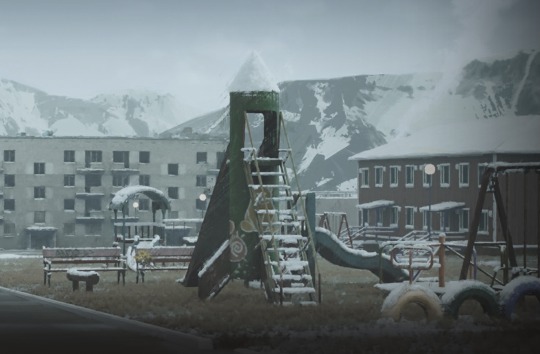
Ijirak, Kikituk, Qiqirn - creatures from Inuit folklore (as far as I know they are not known in native Siberian folklore). I haven’t found information about Hoituk
The Russian word for “most” means “best” in the phrase “the most “most”” (“самый-самый”)
“It was only by luck that we found the runium. For over 60 years, people here have worked together to make it what it is now” - Vila. If the events happen in 60s-80s (judging by the overall vibe), than the last time reverse was at 1977 and Rayashki started to grow from a village to a town at 1917 or later. It means the town exported runium for all the Soviet years.
⬆️ EDIT: Silver Knot (Windsong's story) confirms it actually happens in 80s-90s
Most of the sighs say “For Better Future”, “Welcome to Rayashki” and “Welcome Zeno’s Military Institute”
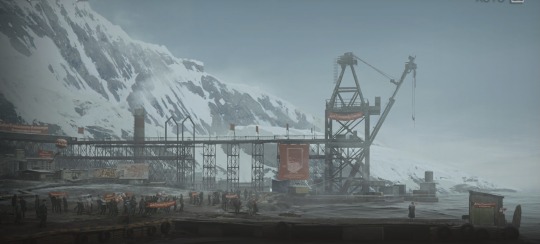
The room in which Windsong stays is Soviet af. There are an old TV with a lens, cool bookshelf and tiles that surprised me. They’re common for public and liminal spaces but not so much for the living ones. Maybe they’re chosen because they endure harsh Artic climate better that wood or linoleum
EDIT: the TV looks like KVN-49 model, produced in 1949—1962

“It must be Kikituk! But their closest habitat should be Kong Kalrs Land, hundreds of kilometres away”. Kong Karls Land - a group of island of Svalbard archipelago, Norway. As @vingler-mirror point out in their post, Rayashki is likely based on Pyramiden town owned by USSR on the same archipelago


Природа это числа и черты - “Nature is numbers and lines” Природа это мозаика цветов - “Nature is a mosaic of colours”
“Mutant Kikituk from Olga area! You should be at the Olga Strait, hunting for migrating salmon and whales, not here!” - excuse me OLGA STRAIT!? THE ONE NEAR JAPAN!?

Poneva/ponyova - an element of Russian (Eastern Slavic?) female clothing worn on top of the main skirt of the dress. I believe there was either a mistranslation in Needles and Loaves message where Raisa said “poneva dress”, either she meant the whole outfit

Samodiva - Their name is feminine and can be roughly translated as “self-wonder”, but that’s another word for vila the creature from Western and Southern Slavic mythology similar to Eastern Slavic rusalka/mavka

Other stuff I’ve noticed:
The town seems to have a big arcanist population, if not most of them are arcanists. An arcanist right is applicable to them and all Vila’s known students are arcanists (if the kids are arcanists, their parents and grandparents are arcanists too)
The people of Rayashki seem to come from different places, and it makes sense with Pyramiden's history (EDIT: the workers were mostly from a western region of Ukraine). Pasono’s first name seems to be obscure and I’ve found only a surname mostly known in America. Patrik’s name is more popular name in other countries, and it make me to believe his ancestors might be foreigners. Bogina’s name comes from Southern Slavic languages
Rayashki is very communistic compared to the rest of USSR. Maybe it’s the town’s history, citizens’ temperament, small town’s size, seclusion and big self sufficiency combined. EDIT: the town's athmosphere conctasts with the period of USSR where people start feel more positive about the world around and capitalism with it
150 notes
·
View notes
Text
MYKOLAIV, UKRAINE—Kateryna Nahorna is getting ready to find trouble.
Part of an all-female team of dog handlers, the 22-year-old is training Ukraine’s technical survey dogs—Belgian Malinois that have learned to sniff out explosives.
The job is huge. Ukraine is now estimated to be the most heavily mined country on Earth. Deminers must survey every area that saw sustained fighting for unexploded mines, missiles, artillery shells, bombs, and a host of other ordnance—almost 25 percent of the country, according to government estimates.
The dogs can cover 1,500 square meters a day. In contrast, human deminers cover 10 square meters a day on average—by quickly narrowing down the areas that manual deminers will need to tackle, the dogs save valuable time.
“This job allows me to be a warrior for my country … but without having to kill anyone,” said Nahorna. “Our men protect us at war, and we do this to protect them at home.”
A highly practical reason drove the women’s recruitment. The specialized dog training was done in Cambodia, by the nonprofit Apopo, and military-aged men are currently not allowed to leave Ukraine.
War has shaken up gender dynamics in the Ukrainian economy, with women taking up jobs traditionally held by men, such as driving trucks or welding. Now, as mobilization ramps up once more, women are becoming increasingly important in roles that are critical for national security.
In Mykolaiv, in the industrial east, Nahorna and her dogs will soon take on one of the biggest targets of Russia’s military strategy when they start to demine the country’s energy infrastructure. Here, women have been stepping in to work in large numbers in steel mills, factories, and railways serving the front line.
It’s a big shift for Ukraine. Before the war, only 48 percent of women over age 15 took part in the workforce — one of the lowest rates in Europe. War has made collecting data on the gender composition of the workforce impossible, but today, 50,000 women serve in the Ukrainian army, compared to 30,000 before the war.
The catalyst came in 2017, years before the current war began. As conflict escalated with Russia in Crimea, the Ukrainian government overturned a Soviet-era law that had previously banned women from 450 occupations.
But obstacles still remain; for example, women are not allowed jobs the government deems too physically demanding. These barriers continue to be chipped away—most recently, women have been cleared to work in underground mines, something they were prevented from doing before.
Viktoriia Avramchuk never thought she would follow her father and husband into the coal mines for DTEK, Ukraine’s largest private energy company.
Her lifelong fear of elevators was a big factor—but there was also the fact that it was illegal for women to work underground.
Her previous job working as a nanny in a local kindergarten disappeared overnight when schools were forced to close at the beginning of the war. After a year of being unemployed, she found that she had few other options.
“I would never have taken the job if I could have afforded not to,” Avramchuk said from her home in Pokrovsk. “But I also wanted to do something to help secure victory, and this was needed.”
The demining work that Nahorna does is urgent in part because more than 55 percent of the country is farmed.
Often called “the breadbasket of Europe,” Ukraine is one of the world’s top exporters of grain. The U.K.-based Tony Blair Institute for Global Change, which has been advising the Ukrainian government on demining technology, estimates that landmines have resulted in annual GDP losses of $11 billion.
“Farmers feel the pressure to plow, which is dangerous,” said Jon Cunliffe, the Ukraine country director of Mines Advisory Group (MAG), a British nonprofit. “So we need to do as much surveying as possible to reduce the size of the possible contamination.”
The dogs can quickly clear an area of heavy vegetation, which greatly speeds up the process of releasing noncontaminated lands back to farmers. If the area is found to be unsafe, human deminers step in to clear the field manually.
“I’m not brave enough to be on the front line,” 29-year-old Iryna Manzevyta said as she slowly and diligently hovered a metal detector over a patch of farmland. “But I had to do something to help, and this seemed like a good alternative to make a difference.”
Groups like MAG are increasingly targeting women. With skilled male deminers regularly being picked up by military recruiters, recruiting women reduces the chances that expensive and time-consuming training will be invested in people who could be drafted to the front line at a moment’s notice. The demining work is expected to take decades, and women, unlike men, cannot be conscripted in Ukraine.
This urgency to recruit women is accelerating a gender shift already underway in the demining sector. Organizations like MAG have looked to recruit women as a way to empower them in local communities. Demining was once a heavily male-dominated sector, but women now make up 30 percent of workers in Vietnam and Colombia, around 40 percent in Cambodia, and more than 50 percent in Myanmar.
In Ukraine, the idea is to make demining an enterprise with “very little expat footprint,” and Cunliffe said that will only be possible by recruiting more women.
“We should not be here in 10 years. Not like in Iraq or South Sudan, where we have been for 30 years, or Vietnam, or Laos,” Cunliffe said. “It’s common sense that we bring in as many women as we can to do that. In five to 10 years, a lot of these women are going to end up being technical field managers, the jobs that are currently being done by old former British military guys, and it will change the face of demining worldwide because they can take those skills across the world.”
Manzevyta is one of the many women whose new job has turned her family dynamics on their head. She has handed over her previous life, running a small online beauty retail site, to her husband, who—though he gripes—stays at home while she is out demining.
“Life is completely different now,” she said, giggling. “I had to teach him how to use the washing machine, which settings to use, everything around the house because I’m mostly absent now.”
More seriously, Manzevyta said that the war has likely changed many women’s career trajectories.
“I can’t imagine people who have done work like this going back and working as florists once the war is over,” she laughed.
57 notes
·
View notes
Text
I've just seen a russian who was talking about "ThAt Is NoT ThAT PlAiN As UkRaInIaNs SAy" saying taht "BuT UkRaInIaNs ArE boMbInG KuRsK AnD beLgORoD". you are a fucking scum and I won't be taking my words back. I will never take them back because russians are a biological waste. and here's why the shit she said isn't a valid point in an argument (claiming that russia is not that bad):
1. they've invaded our territories back in 2014 and occupied crimea (do I have to mention that they've deported crimean native people away from their homeland in 1944 and then passed crimea into ukrainian ussr's hands because all russia's brought there was sorrow and destruction?) and have also invaded donetsk and luhansk regions which then became the first combat zones of russian invasion in ukraine. that's when the war's actually started
2. they planned to "take kIEv over in 3 days" but obviously they failed. and when they realised that it was over for them they started murdering civilians as they were fleeing from a battlefield. we didn't plan on taking moscow over or smth. in fact we just don't need their swamps lands, we want to live on our land without the constant fear of being killed. but they obviously are obsessed with occupying more and more territories (while they can't even provide a mediocre level of life on the lands they already have stolen)
3. I don't really see western zoo & eco activists talking about it, but russia's committed an ecocide somewhere around a year ago by blowing up a nova kakhovka dam. many people (esp elderly people) and animals died. they drowned in their own houses
4. let's not forget that russia is actively destroying ukrainian fields too. and ukraine was a massive exporter of wheat to the whole europe and even africa
5. russia is bombing kharkiv, odesa and several more regions that are located near an active battlefield zone daily. kharkiv's electric infrastructure is destroyed to the point that they cannot produce electricity for themselves so all of the other regions of ukraine are having their electricity turned off for several hours several times a day. daily. in order to help ppl in kharkiv
6. and let's not stay silent about people on the occupied territories. I often write about this because this is truly horrifying. ukrainian schools are totally banned, instead education is in russian, russian propaganda is being put into ukrainian children's heads, they turn on a russian hymn in those schools every day. and the kids truly hate that. I've seen stories of teachers who teach online and some children from occupied territories are their students. so these students have to catch the internet somewhere on the roof of a barn in the middle of the night just to learn IN UKRAINIAN. why at night? because if they get busted while learning in ukrainian they'd be taken away from their parents and placed into foster families somewhere in russia. same goes for publicly speaking in ukrainian. and that's just the top of the iceberg because too much terrible shit is happening in ukrainian regions occupied by russia
7. the way russians treat our war prisoners (soldiers and civilian captives). beating up, raping, torturing, killing, starving. that's what they do. ukrainians, on the other hand, keep all the war prisoners (soldiers only obviously) according to the international law. the worst thing we can do to them is humiliate them on the internet (tho it's happened only once or twice with certain individuals)
that's not all but that's enough. and if it's not enough for you to become more loyal towards ukrainians I have some bad news for you
20 notes
·
View notes
Text
Brussels has set up a defensive office within the EU bureaucracy called “The Trump Task Force.”
"The leaders of the European Union are nervous about President Trump: (1) ending the war in Ukraine, and then (2) ending the Marshal Plan, thereby taxing their exports to the U.S as Trump demands tariff reciprocity; and lastly (3) forcing them to pay for their previous NATO commitments." - Sundance


BRUSSELS — Top European Union officials have met with the bloc’s ambassadors to talk through what it would mean if Donald Trump wins the U.S. election, 12 EU diplomats told POLITICO.
“They’re worried about trade but mostly [about] Ukraine,” one of the diplomats said, adding that Brussels foresees “abrupt changes on U.S. policy even before the inauguration.” The diplomat, like others quoted in this piece, was granted anonymity to speak candidly.
The conversations revolved around two areas of uncertainty should the Republican candidate reclaim the White House: Whether Washington would continue to support Ukraine and the prospect of higher U.S. tariffs for all incoming goods.
[…] The meetings come amid reports the bloc has set up a rapid reaction force to prepare for the fallout of the elections, colloquially known as the “Trump task force.” The EU wants to hit back hard on trade if Trump wins.
Trump has warned that he won’t defend “delinquent” NATO allies spending less than 2 percent of GDP on defense. And he has threatened to slap 10 to 20 percent tariffs on all imports to bring manufacturing jobs back to the U.S. On Thursday, Trump called the EU a “mini China.”
“They don’t take our cars, they don’t take our farm products, don’t take anything. You have a $312 billion deficit with the EU. You know, the EU is a mini — but not so mini — is a mini China,” he said.
Three of the diplomats said that the discussions also touched upon the EU’s relations with China, with Trump set to antagonize Beijing even more. The meetings involve six Commission departments and cover topics such as trade, energy and digital policy — areas that could experience turbulence if Trump returns to the White House. (read more)
#trump 2024#european union#zelensky#WEF#klaus schwab#olaf scholz#jens stoltenberg#ursula von der leyen
8 notes
·
View notes
Text
23 August - Day of the National Flag of Ukraine
Day of the National/State Flag of Ukraine - День державного прапора Україн��

What is the meaning behind the National Flag?
It is comprised of two colours - blue and yellow, which represent the clear blue sky and the golden wheat field underneath. Why so? Well, generally speaking, it is a very typical scenery for Ukraine, as Ukrainians have had a strong connection with nature and agriculture for centuries. Moreover, even nowadays (at least, prior to the full-scale russian invasion in 2022) the majority of produced goods are grains, in particular wheat, corn, and sunflower seeds/oil (for this reason some people even referred to Ukraine as 'the bread basket of Europe').
Just to give you some infographics
In 2021, Ukraine was
• one of the top 5 world wheat exporters (5th place) (The World’s Top Wheat Exporters In 2021 (rferl.org)
• one of the top 3 world corn exporters (3rd place) Corn | OEC - The Observatory of Economic Complexity
• and the biggest sunflower oil exporter in the world (1st place) quote: "Since 2012, Ukraine has been the world's leading exporter of sunflower oil with a 47% share of global sunflower oil exports in 2021." (Ukraine: Sunflower oil production (October 2022) - Ukraine | ReliefWeb)

Vocabulary:
День - den - day
Прапор - prapor - flag
Національний - natseeonalny - national (masculine form of the adjective)
Державний - derzhavny - state (masculine form of the adjective)
Україна - Oo-kra-yee-na - Ukraine
Серпень - serpen - August
#ukrainian language#ukrainian#ukrainian101#ukrainian vocabulary#learning languages#language learning#ua lang#ukraine#langblr#slavic languages#learnsomethingneweveryday#learning#self studying#polyglot#Language blog#foreign languages#learnukrainian#learn ukrainian
54 notes
·
View notes
Text
Switzerland has for years been the destination of choice for Russian oligarchs and corrupt officials to hide their stolen money. Swiss banks are estimated to hold over $200 billion in stashed Russian cash.
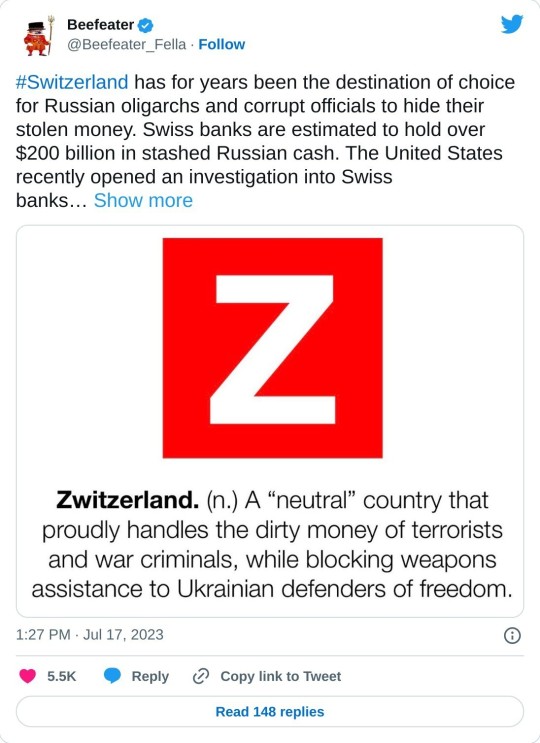
The United States recently opened an investigation into Swiss banks helping #Russia to evade sanctions, subpoenaing the two largest Swiss banks at the time. Switzerland is also key to Russian #evasion of export controls meant to ensure Russia cannot resupply its military and continue its war.
Russian-induced corruption within the Swiss law enforcement system led to the resignation of the former top prosecutor of Switzerland and the conviction of a senior Swiss law enforcement official on bribery charges. Switzerland is now primed to send millions in frozen Russian dirty money related to the revelations of Sergei Magnitsky to the Russians who stole it.
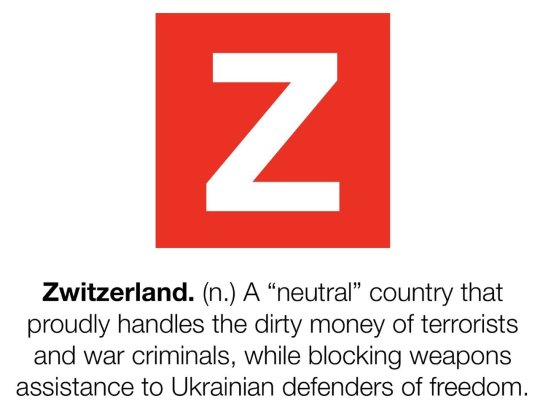
This hearing will examine Switzerland’s key role in laundering Russian money. Witnesses will discuss how Switzerland came to be a favorite destination for Russian dirty money, how Russian corruption in Switzerland endangers U.S. national security and the ability of Ukraine to defend itself, and possible policy responses. This hearing builds on years of work by the #Commission to hold Switzerland to account for its role in Russian money laundering and corruption.
The following witnesses are scheduled to testify:
1Bill Browder, Global Magnitsky Justice Campaign
2Drew Sullivan, Co-Founder, Organized Crime and Corruption Reporting Project (OCCRP)
3Olena Tregub, Secretary General, Independent Defense Anti-Corruption Committee (NAKO)
HEARING
Russia’s Alpine Assets: Money Laundering and Sanctions Evasion in Switzerland
July 18, 2023
1:00 p.m.
Senate Dirksen Building G50
Live stream:
youtube.com/watch?v=dxX98X…
#switerland#russian oligarchs#swiss banks#russian induced corruption#bribery charges against senior swiss law enforcement official#us national security#ukraine resistance#stop russian invasion#stop russian money laundering#give russian money in switerland to ukraine#ukraine war#help ukraine#give weapons to ukraine#i stand with ukraine#slava ukraini
61 notes
·
View notes
Text
4 notes
·
View notes
Text
Have I ever told y’all how much I hate fellow Americans sometimes?
Anyways. Russia is trying to hide jets by gluing spare tires to them, Ukraine has taken a port, there’s another coup starting in the Congo, China grows increasingly aggressive in the Taiwan Strait, cocaine is about to surpass oil as Columbia’s top export, the F-35 is apparently stealthy enough that not even the US government could find the lost one for more than a day, and there is no insider trading in Ba Sing Se (Unity is absolutely fucking up right now).
37 notes
·
View notes
Text
https://www.seair.co.in/blog/exports-of-ukraine.aspx
Discover major exports of Ukraine, including cereals, iron and steel, and sunflower oil. Learn about Ukraine's top export partners like Poland and China, and explore the country's significant role in global trade.

#exports of Ukraine#major export of Ukraine#hs code ukraine#Ukraine export products#Ukraine trade data#Ukraine export data#main export of Ukraine#ukraine top exports#Ukraine biggest export#Ukraine export by country
0 notes
Text
Why Vesna’s “My sister’s crown” in no feminist anthem but a Trojan horse filled with pro-russian messaging
My thoughts as a Ukrainian with a poli-sci degree.
I was debating whether to write this post but as the discourse around this song grows, I want to give people from other countries some context on the messaging used in the song and why Ukrainians are grossed out by it.
While I was writing it this post grew a mind of its own and I even ended up adding pictures so I'll fold the post here in case you don't care and just want to scroll through quickly.
First of all, it’s worth mentioning that this song attracted so much attention from Ukrainians because they use UKRAINIAN LANGUAGE in the chorus. It’s an important detail seeing how one of the singers is russian. A lot of Ukrainians share the opinion that letting a russian woman sing in our language is a completely vile thing to do to our culture. I agree with it too. But the abuse of our culture doesn’t stop there.
See this shot? This is supposed to be Borsch, a traditional Ukrainian dish. It’s worth mentioning that russia tried to appropriate this dish and in 2022 we fought tooth and nail to have UNESCO protect it as part of Ukrainian heritage. But back to the shot. The letters around it are supposed to symbolize russian propaganda. Great start🙄

But it gets better, lads. They start “feeding the propaganda” to the girl that —judging by stylistic choices as well as matryoshka makeup— is supposed to represent russian people.


Right, so they *checks notes* use Ukrainian cultural dish —that russians almost succeeded in stealing from us— to show… what exactly? “Poor russians🥺 uwu” getting brainwashed? Oh, then let me grab my handkerchief. This is so so sad I think I’m about to cry😶😶😶
I mean, just a thought but if they wanted to show how shitty russian government treats its people, they could’ve recreated the historically accurate moment when russian tzar Ivan the Terrible shoved his underling’s face into a boiling soup. What does Ukraine and our long-suffering dish has to do with all this bs???
Now let’s talk about that “Crown”, that is supposed to belong to the sister (aka Ukraine). To me, as a poli-sci major, this is so stupid I don’t even know whether to laugh or cry. From the words of the band themself, where they explain —quite poorly might I say— the meaning of their song, we learn that “Crown” symbolizes the sovereignty of the 13 Eastern-European countries. Sounds perfectly valid. Here's a few random countries that I can remember from the top of my head in no particular order that have crowns in their symbols:
Coat of arms of the Czech Republic, Coat of arms of Serbia, Flag of Poland and Flag of Croatia

I actually decided that I don't want to have russian flag and emblem in this post because I don't want to look at it every time I scroll through, but you can go google it if you want, they have not one but two crowns on their emblem actually.
So what am I leading up to with all this flag-talk, you might ask. Well, the kicker is that THIS ⬇️ is Ukrainian emblem:

Not a crown in sight as you can see. I guess as a nation that was constantly fighting against imperial colonisation we’re not very fond of those. Who could’ve guessed🤷♀️
But the aforementioned two points are pretty circumstantial and in the grand scheme of things are not particularly significant. I felt compelled to point them out first to give people from other countries a bit of insight into the music video's visual. You are free to disagree with me on those. The main problem that triggers the majority of Ukrainians is the use of the word "sister". Listen, I know you don’t want to read a lecture on the nuance of Slav politics and I don’t really want to write it, I know you know how to google. So here’s the gist:
One of the BIGGEST narratives that russia is pushing in its export propaganda (aside from their go-to claim that all ukrainians are nazis) is that Slavs are all a family. Talk about shitty relatives, eh? But basically, it’s a lingering thing from USSR where russia exploited a bunch of neighboring countries and called this shit a “Union” (while convincing the rest of the world that those countries entered that union willingly and not under threats —or as a result of— hostile invasions, but I digress). So the way russia frames it is that russia is this big brother that "takes care of other little siblings”. Even writing it down made me want to barf🤢🤢🤢. This narrative was specifically very actively weaponized against Ukraine before the 2022 invasion. Its goal is to infantilize Ukraine as if we're not a whole-ass independent country, but a little sibling that doesn't know how to wipe their own ass. And that we just need good ol’ russia to come and save us from our own stupidity. I hope I shed some light on why this word specifically triggers us so much and why I think that this song has 0 to do with solidarity and overall is complete populistic bs with a generous dash of russian propaganda.
I want to emphasize that I didn’t make this post to fight or argue with anyone but to give people another perspective if you’re interested in it from my pov as a Ukrainian. If you have other takes on it, I’d love to read them in the comments. Just please be respectful or I won’t interact.
This is all I have to say for today. Love, love, peace, peace, my dudes.
78 notes
·
View notes
Text

Ukraine Says It’s Getting Long-Range Strike Missiles With Its F-16s
A top Ukrainian defense official says the country is awaiting strike weapons with a range of 300-500 kilometers for its future F-16s.
Thomas NewdickPUBLISHED Feb 5, 2024 6:10 PM EST
F-16 for Ukraine will be getting a long-range cruise missile, according to the country's Air Force chief.
USAF
An undisclosed type of air-launched cruise missile with a range of up to 300 miles will be among the munitions delivered to Ukraine alongside its long-awaited F-16 fighters, according to Lt. Gen. Serhii Naev, the commander of the Joint Forces of the Armed Forces of Ukraine.
In a statement reported by the Ukrainian RBC news outlet, Naev said that the deliveries of F-16s were expected to be accompanied by air-to-ground missiles to arm them, with a range of “300-500 kilometers” — 186 to 310 miles. Naev added that the weapons were expected to arrive in “further military aid packages,” but provided no more details.

Lt. Gen. Serhii Naev, the commander of the Joint Forces of the Armed Forces of Ukraine. Ministry of Defense of Ukraine
Back in the summer of last year, when the idea of Ukraine getting F-16s finally became a more concrete reality, we looked at the extensive ‘menu’ of possible air-to-ground and air-to-air munitions to arm these aircraft.
What is especially notable about Naev’s claim, however, is the stated range of 186 to 310 miles — a significant distance. Exactly what missile he is referring to isn’t clear, but among the likely candidates that fits that description is the AGM-158 Joint Air-to-Surface Standoff Missile or JASSM.
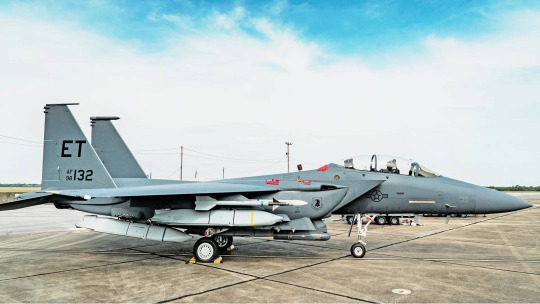
A U.S. Air Force F-15E Strike Eagle loaded with five JASSMs at Eglin Air Force Base, on May 11, 2021, as part of Project Strike Rodeo, which you can read more about here. U.S. Air Force
In its initial AGM-158A form, the JASSM has a range of around 330 miles and weighs 2,250 pounds. The extended-range AGM-158B variant, or JASSM-ER, has a publicly stated range of at least 575 miles. An even longer-range version of the JASSM is in the works, but this has not been fielded yet by the U.S. military.
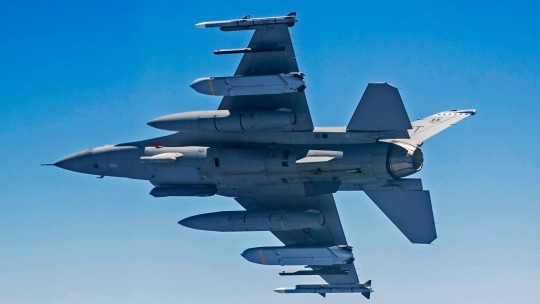
F-16 carrying JASSMs on a test flight. U.S. Air Force photos by Staff Sgt. Brandi Hansen
Although in service for some 20 years, JASSM remains a very sophisticated weapon, with significant low-observable (stealth) characteristics that add dramatically to its survivability. Full of complex and classified technologies, this air-launched cruise missile, even if supplied in its oldest form, would be a massive leap in capability for Ukraine. It would be especially useful for deeply penetrating the dense Russian air defense overlay that sits atop occupied territories in Ukraine.
While the U.S. has exported JASSM widely to key allies, handing it over to Ukraine to be used against a major foe, and having the possibility of it falling into enemy hands, remains a questionable proposition. Yet at this point, considering similar escalation in high-end weaponry provided to Ukraine, it certainly is possible.
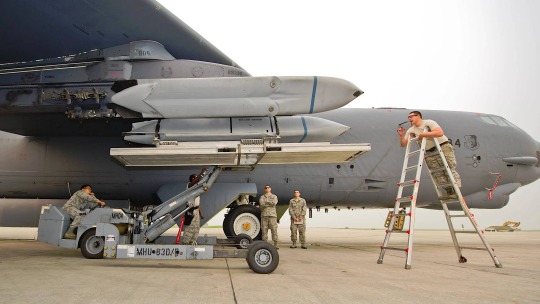
U.S. Air Force personnel load AGM-158 JASSM-series cruise missiles onto pylons under the wing of a B-52. U.S. Air Force
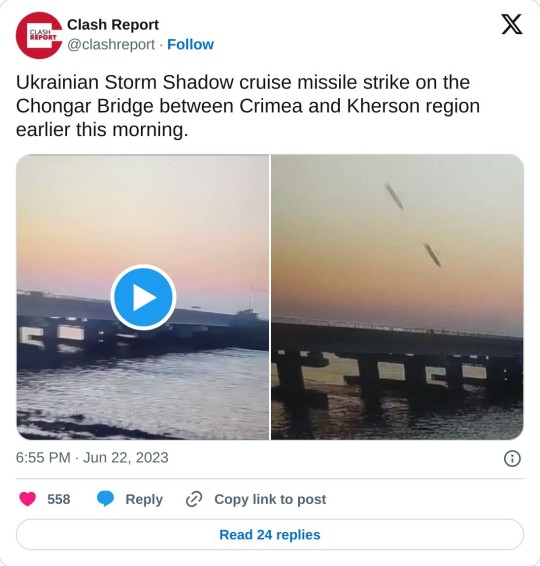
Another long-range weapon integrated on the F-16, but less well known, is the AGM-84H Standoff Land Attack Missile–Expanded Response, better known as SLAM-ER, introduced on Turkish Vipers.
In the past, The War Zone argued that the SLAM-ER could be the most likely U.S.-supplied air-launched cruise missile for the Ukrainian F-16, also bearing in mind its availability in the U.S. Navy inventory and its lower degree of technological sensitivity compared to JASSM. The missile has a range of about 170 miles.
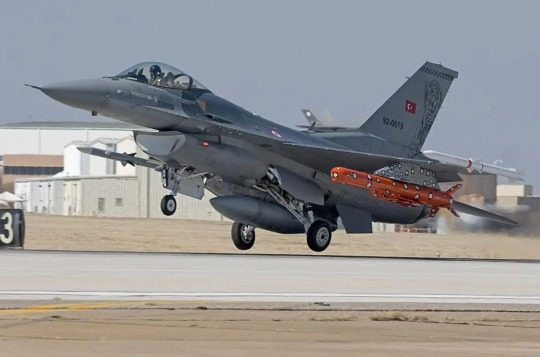
A Turkish F-16 carrying a SLAM-ER captive round during integration work. Lockheed Martin
As previously described, the highly accurate SLAM-ER can be used in a fire-and-forget mode against a known target. Alternatively, it can be operated using a ‘man in the loop’ (MITL) control concept. This involves a two-way datalink pod on the launching aircraft that allows the missile to be manually steered by the aircraft’s crew to its final impact point after it makes its way autonomously to the target area. This allows very precise targeting, re-targeting in real-time, and even the ability to engage certain moving targets.
Then there is the U.K.-supplied Storm Shadow, and the similar French-supplied SCALP EG cruise missiles have already been used to significant effect, launched by Ukrainian Su-24 Fencer strike aircraft.

A SCALP-EG, the French variant of the Storm Shadow air-launched cruise missile, loaded under the wing of a Su-24 Fencer. Ukrainian Ministry of Defense screencap
Many observers were surprised at how quickly Storm Shadow and SCALP EG were integrated on a Soviet-era platform. While it’s notable that neither of these weapons has been integrated on the F-16, there may well be time to complete such work before these jets arrive in Ukraine. The missiles should be able to be integrated with relative ease, considering they use the same NATO-standard data bus architecture that’s found on the Viper. The 2,900-pound weapons could potentially be mounted on the inboard wing stations, which can accommodate 3,500 pounds. While the Storm Shadow/SCALP-EG export configurations have a range of around 155 miles, the non-export configurations are roughly double that.
Another European air-launched cruise missile that has been suggested for Ukraine is the German Taurus KEPD 350, although its supply has so far been blocked by the German government. Nevertheless, if the go-ahead were given, the manufacturer, Taurus Systems, says it would take between 12 and 18 months to be integrated onto the F-16. This missile has a stated range of around 500 kilometers (310 miles).
Then there is the possibility that an indigenous weapon could foot the bill. This would most likely be an air-launched variant of the ground-attack-optimized Neptune cruise missile. We have seen no information that Neptune is being adapted for air launch, but it’s worth mentioning it as a possibility, even if remote.
In our previous analysis of potential Ukrainian F-16 weapons, one, in particular, was described as “perhaps the most likely and exciting new advanced weapon Ukraine would receive with its Vipers.” This is the AGM-154 Joint Stand-Off Weapon (JSOW), which could still be a critical tool for these fighters, despite its much shorter range than some other options.

A pair of live JSOWs on a Greek F-16. Ioannis Lekkas
“[JSOW] is very well suited for the unique combat environment in Ukraine. It can autonomously glide to its target from over 70 miles away when launched at altitude or over a dozen miles when launched at low altitude. It could be especially useful for target geolocated static/semi-static air defense systems and its imaging infrared sensor it uses for terminal homing is impervious to radio-frequency jamming. It has a very small signature, as well, making it that much harder for Russian air defenses to shoot down.”
Despite being unpowered, its range is sufficient for JSOW to be launched from outside the range of the enemy’s air defense systems. What is more, JSOW is available both with a unitary blast-fragmentation/penetrator warhead (as used by the U.S. military), while earlier versions, which may still be available, can also carry submunitions warheads, a type of payload that Ukraine has already made use of on other U.S.-supplied long-range weapons.
youtube
At this point, there has been no confirmation from U.S. officials that an air-launched standoff munition will be included in future arms transfers to Ukraine. But it would clearly make sense as Ukraine seeks to target objectives further from the front lines.
Other longer-range weapons have already been able to bring destruction to Russian command posts and logistic storage sites, as well as air defenses and docked vessels, that were previously outside the range of Ukrainian attacks.
Any new air-launched standoff munitions for Ukraine would likely be used against similar target sets.
As Nayev noted in the same article, the appearance of longer-range systems, including the M142 High Mobility Artillery Rocket Systems, or HIMARS, provided to Ukraine earlier in the conflict, has had a tangible effect on how Russia is able to wage its war, pushing logistical support and command posts further from the front lines.
An M142 HIMARS launches a rocket against the Bakhmut direction on May 18, 2023, in the Donetsk region, eastern Ukraine. Photo by Serhii Mykhalchuk/Global Images Ukraine via Getty Images
“This has led to an increase in the logistical burden of transporting ammunition and material resources, the complication of troop management, the loss of offensive capabilities, and the transition to forced defense (and eventually to the ‘gesture of goodwill’ from the right bank of the Dnieper and the evacuation from Kherson,” Naev said.
Nayev’s ironic description of Russia’s “gesture of goodwill” refers to the retreat across the Dnieper River in late 2022, part of a withdrawal of the Kremlin’s forces from the Kherson region in southern Ukraine.
These types of impacts have been repeatedly seen with advanced weapon systems. ATACMS ballistic missiles provided by the U.S. rolled back the menacing threat, at least to a significant degree, from Russian attack helicopters, for instance.
Based on previous patterns, we may well first learn of the identity of any new type of air-launched cruise missile for Ukraine once it starts arming the country’s F-16s.
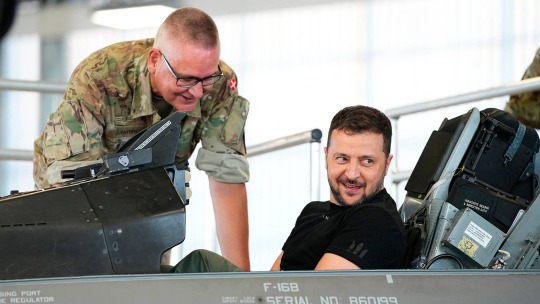
Ukrainian President Volodymyr Zelensky (right) sits in an F-16 fighter at Skrydstrup Air Base in northern Denmark, on August 20, 2023. Photo by MADS CLAUS RASMUSSEN/Ritzau Scanpix/AFP via Getty Images
Whatever the case, the prospect of F-16s taking the war to the Russians in Ukrainian Air Force colors is moving ever closer.
Last month, a senior Pentagon official said that the United States expected the Ukrainian Air Force to achieve initial operating capability on F-16s by the end of this year.
Already, a multinational training effort for Ukrainian F-16 pilots is taking place in the United States and in Europe.
“We are aiming to provide an initial operating capability for Ukraine with its F-16 program in 2024, which would entail trained pilots, the platforms, but in addition, trained maintainers and sustainers, infrastructure, and spare parts, ammunition,” Celeste Wallander, assistant secretary of defense for international security affairs, told reporters on January 24.

One of the first five ex-Netherlands F-16s that will be used to train Ukrainian pilots as part of a European initiative arrived in Romania last November. Dutch Ministry of Defense
As we have discussed in the past, however, working up to even austere initial operating capability is a major task for a country that’s not only at war but has no real experience in daily operations with Western-made, NATO-compatible fighters.
At this stage, the focus is very much on training pilots and maintainers, as well as securing the F-16s themselves, with the jets being sourced from a variety of European nations. So far, Belgium, Denmark, the Netherlands, and Norway have all said they will provide Ukraine with F-16s. The Dutch Ministry of Defense confirmed only today that it would provide another six F-16s to Ukraine, on top of the 18 examples it had already earmarked for the F-16 training center in Romania.

The specifics of how Ukraine will actually take its F-16s to war remain unclear, including what weapons they will be armed with. It’s notable that none of the European partner nations that have committed to providing F-16s to Ukraine arm them with JSOW or JASSM, so these would likely have to come from the United States or another benefactor, regardless. Regardless, the provision of any type of weapons for the F-16s would need to be signed off by Washington.
It has long been expected that once combat-capable, Ukrainian F-16 pilots will use the fighters to try and wrest air superiority over Ukraine, as well as use the aircraft’s superior air-to-air radar and weapons to tackle cruise missiles and drones.
On the other hand, the success that’s already been achieved by the Storm Shadow and SCALP EG, and the limited stocks of both those weapons, could see Ukraine want to push its F-16s into offensive operations sooner rather than later. In that context, the appropriate standoff weapons to arm them would be fundamental. Standoff strike would also be an easily executable mission for new F-16 pilots.
It needs to be remembered, however, that, like other long-range strike weapons provided by Western allies, the F-16 and standoff missile combination will not be permitted for use against targets within Russia’s internationally recognized borders.
Now that Kyiv has secured F-16s, and their arrival in the country might now be counted in months only, it’s understandable that securing weapons for these aircraft is now a higher priority. While there are no other signs that a specific air-launched cruise missile has already been approved for transfer to Kyiv, Nayev’s words clearly point to aspirations to use the F-16 in a long-range strike role, holding yet more critical Russian targets to threat within Ukraine’s borders.
Contact the author: [email protected]
9 notes
·
View notes
Text
Iranian President Ebrahim Raisi died on Sunday when a helicopter carrying him and a delegation of other Iranian officials crash-landed in the mountains of northern Iran, throwing the future of the country and the region into further doubt.
Foreign Minister Hossein Amir-Abdollahian and other top officials were also killed in the crash as the group was traveling in Iran’s East Azerbaijan province, the Iranian state-run Islamic Republic News Agency confirmed. Dense fog impeded search and rescue operations for hours before the crash site was found. The fog was so thick that it forced the Iranians to call on the support of European Union satellites to help locate the helicopter.
Raisi’s death puts a coda on a short but transformative era in Iranian politics that saw the country lurch in a hard-line direction and threatened to bring the Middle East to the brink of regional war. In nearly three years in power, Raisi moved Iran’s domestic politics and social policy in a more conservative direction and pushed the country further into the role of clear U.S. antagonist in the region after his predecessor, Hassan Rouhani—who defeated him in the 2017 presidential election—first sought a detente with the West over Iran’s nuclear program before stepping up proxy attacks.
An Islamic jurist noted for his close relationship with Ayatollah Ali Khamenei and considered by many officials and experts as a likely candidate to succeed the aging supreme leader, Raisi’s tenure saw Iran speed up uranium enrichment and slow down negotiations on the Joint Comprehensive Plan of Action after the United States exited the deal in 2018, three years before he came into office.
Iran under Raisi also supported Russia in its war against Ukraine with extensive exports of Shahed suicide drones and artillery; increased attacks by regional proxy militias against the United States and Israel after Hamas’s October 2023 cross-border attack on Israel; and just a month before his death launched a massive drone and missile attack against Israel.
Experts say that regardless of who replaces Raisi, the strategy he pursued is unlikely to change, having been solidified among the higher echelons of Iran’s political and clerical leadership.
“With Raisi, without Raisi, the regime is quite content with the way the post-Oct. 7 Middle East has been shaking out,” said Behnam Ben Taleblu, a senior fellow focused on Iran at the Foundation for Defense of Democracies (FDD). “It’s been able to continue its death-by-a-thousand-cuts strategy, firing directly against the U.S. and Israel via proxy and then even directly a few times itself with the tit-for-tat you saw in April, and still look like it won the round.”
Under the Iranian Constitution, First Vice President Mohammad Mokhber is likely to fill in as head of the cabinet for the next 50 days until elections can be called. Recent parliamentary elections drew record-low turnouts, analysts said. What’s more, significant effort was expended by Khamenei and his allies to ensure Raisi’s win during the last presidential election in 2021, disqualifying potential rivals.
Before becoming president, Raisi served on Iran’s prosecution committee that was responsible for executing an estimated 5,000 dissidents in 1988. He had been accused of crimes against humanity by the United Nations and was sanctioned by the U.S. Treasury Department. And that heavy-handed approach continued with the death of 22-year-old Mahsa Amini in the custody of Iran’s morality police in September 2022 after allegedly not wearing a hijab properly in public, which sparked nationwide protests.
Beyond the horizon of snap elections and the presidential election set for next year, there is potential for upheaval at the top of Iran’s ruling class. With a short line of possible successors to the 85-year-old Khamenei, other than the head of state’s son, Mojtaba Khamenei, Raisi’s death could throw the country’s political future into further turmoil.
The Islamic Revolutionary Guard Corps (IRGC), the largest branch of the Iranian armed forces that controls major swaths of the country’s economy, could also use the upheaval to strengthen its hand.
“There is no heir apparent if he’s gone,” said David Des Roches, a professor at the National Defense University’s Near East South Asia Center for Strategic Studies and retired U.S. Army colonel. “What’s really interesting is to see if the IRGC will basically complete a slow-motion coup.”
As rescue workers searched for Raisi’s downed helicopter, state media asked the Iranian people to pray for him. Instead, in the wake of reports of the crash, some Iranians appeared to light celebratory fireworks, cheering the demise of the hard-line leader.
“Today’s crash & likely death of president Raisi and his [foreign minister] will shake up Iranian politics,” Afshon Ostovar, an associate professor at the Naval Postgraduate School and a longtime Iran expert, wrote in a post on X before the president’s death had been confirmed. “Regardless of the cause, perceptions of foul play will be rife within the regime. Ambitious elements may press for advantage, compelling reactions from other parts of the regime. Buckle up.”
While experts said it was unlikely that a liberalizing figure would emerge in either snap elections or Iran’s 2025 presidential election, Raisi’s death could leave a small opening for resurgent protest movements that have persisted under the surface.
“These movements are not dead,” said Ben Taleblu, the FDD expert. “They operate on the low level, on the periphery—usually strikes, labor unions, that kind of thing. It could lead to a nationwide trigger, and it could be a nothing burger. But the story of the Iranian protest movement is always a matter of when and not if.”
28 notes
·
View notes
Text
Ukraine is hitting Russia where it hurts – in its fossil fuel industry.
Ukrainian drones have attacked several oil refineries in Russia, hundreds of kilometres from the frontline in regions including Ryazan, Nizhny Novgorod and Leningrad. The continuing attacks are part of a strategy to hurt Russia’s economy. The Ryazan oil refinery, Rosneft’s biggest refinery, was set ablaze, a regional governor said on Wednesday. It shut down two damaged primary oil refining units. Rosneft did not comment. The plant handles about 5.8% of Russia’s total refined crude, according to industry sources. A fire broke out at Norsi, Russia’s fourth-largest refinery, after a Ukrainian drone attack, Russian officials said on Tuesday. Its main crude distillation unit was damaged, which means that at least half of the refinery’s production is halted, according to industry sources. Norsi handles nearly 6% of Russia’s total refined crude. Before the latest drone attack, one of its two catalytic crackers had already been put out of action. The governor of the Leningrad region, Alexander Drozdenko, said a Ukrainian drone targeted the Kirishi refinery. It is one of the top two refineries in Russia, handling 6.4% of Russia’s capacity, according to industry sources. And the Novoshakhtinsk export oil refinery in Russia’s southern Rostov region had to suspend operations on Wednesday after a drone attack.
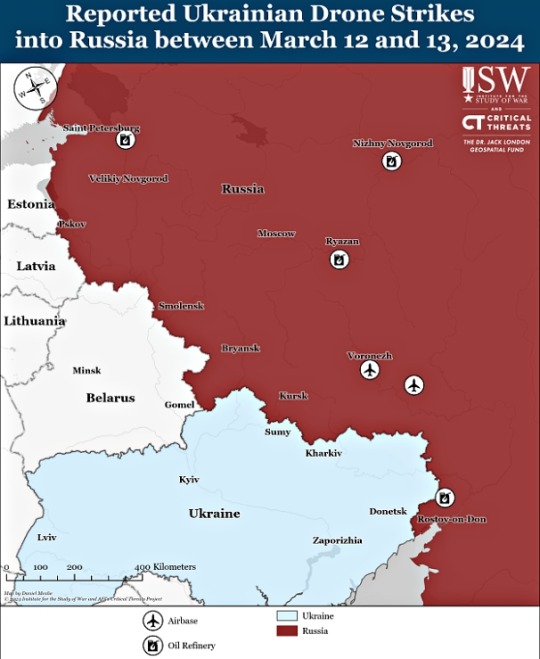
Russia's economy is about the same size as that of Italy which has maybe 40% as many people as Russia. And much of that economy is centered on fossil fuels. Putin and his oligarch buddies skim off graft to enrich themselves; those superyachts, palaces, and prime real estate properties abroad are all ultimately paid for by countries which import Russian oil and gas. Meanwhile, Russians outside the big cities live in poverty; imagine a 1920s standard of living but with censored internet and state TV.
Ukraine is doing the climate a big favor by indirectly encouraging importers of Russian fossil fuels to look for cleaner replacements.
Some other bits of good news for Ukraine...
EU agrees to €5 billion boost in Ukraine military aid
European Union member states agreed Wednesday to provide Ukraine with an additional €5 billion ($5.5 billion) in military aid. Belgium, which holds the EU's rotating presidency, said ambassadors from the bloc's 27 nations had agreed "in principle" on the plan to support arms supplies to Kyiv in 2024. The contribution of €5 billion will go on EU-managed fund called the European Peace Facility. The fund operates as a giant cashback scheme, giving EU members refunds for sending munitions to other countries. Ukrainian Foreign Minister Dmytro Kuleba called it a "powerful and timely demonstration of European unity."
White House announces $300 million military aid package for Ukraine
With new aid for Ukraine stalled in Congress since December, the White House on Tuesday announced it had cobbled together another $300 million in military assistance to use as a stopgap measure. "The package includes munitions and rounds to help Ukraine hold the line against Russia's brutal attacks for the next couple of weeks,” President Joe Biden said in a meeting with Polish President Andrzej Duda and Prime Minister Donald Tusk at the White House, adding, "we must act before it literally is too late.” National security adviser Jake Sullivan detailed the package at White House briefing, saying that the aid comes as Ukraine "does not have enough ammunition to fire back." "So today, on behalf of President Biden, I'm announcing an emergency package of security assistance of $300 million worth of weapons and equipment to address some of Ukraine's pressing needs," Sullivan said.
French National Assembly approves bilateral security agreement with Ukraine
The 10-year security pact with Ukraine includes commitments by Paris to deliver more arms, train soldiers and send up to 3 billion euros ($3.2 billion) in military aid to Ukraine in 2024. Macron has also adopted a tougher stance towards Russia, urging Ukraine's allies to urgently do more. He also did not rule out the presence of Western troops in Ukraine which has created a backlash among some Ukrainian officials had told Reuters they were worried that a vote not overwhelmingly in favour of Kyiv would be negative symbolically and could hurt President Emmanuel Macron's efforts to ramp up his country's support in the coming months.
AOC says Democrats must take advantage of ‘razor-thin’ House margin after Ken Buck steps down
In an unexpected Tuesday evening announcement, Mr Buck — a Republican from Colorado — said he would leave Congress next Friday, rather than retiring at the end of his term as originally planned. Afterwards, Republicans will hold just 218 seats out of 435 in the House, leaving Democrats one step closer to clinching the majority. Representative Alexandria Ocasio-Cortez, a Democrat from New York and member of the progressive Squad, told The Independent her party must take advantage of Mr Buck’s early departure. Ms Ocasio-Cortez said Democrats “have to make sure that that we see that do the best we can to navigate how razor-thin the situation is.”
That last item is rather interesting. Ken Buck, a never-Trump Republican, is stepping down early. His seat in a deep red district will be vacant until late June when a special election is likely to take place. His departure will leave the House GOP (for now) with 218 seats – the bare minimum for a majority. This will make it easier for Democrats to persuade several remaining anti-Putin Republicans to defy Speaker "MAGA Mike" Johnson's wishes and support President Biden's aid package for Ukraine.
#invasion of ukraine#fossil fuels#oil refineries#russia#drone strikes#rosneft#european union#aid to ukraine#us security assistance to ukraine#france#assemblée nationale#ken buck#co-04#us house of representatives#“maga mike” johnson#republicans#ukraine aid now#vladimir putin#russia's war of aggression#роснефть#россия#бпла#владимир путин#добей путина#руки прочь от украины!#геть з україни#деокупація#йдемо на ви#слава україні!#героям слава!
9 notes
·
View notes
Text
"One might think that an intelligence failure can be benign: The good guys do far better than expected, the bad guys far worse. In fact, erring on the side of pessimism can be as big a problem as being too bullish. The period just before and after Russia began its full-scale invasion of Ukraine, in February 2022, is a good example of this. At the West’s most influential research organizations, prominent analysts—many of them political scientists who follow Russian military affairs—confidently predicted that Russia would defeat its smaller neighbor within weeks. American military leaders believed this consensus, to the point that the Joint Chiefs of Staff chair reportedly told members of Congress that Kyiv could fall within 72 hours of a Russian attack. Although those analysts’ gloomy assessments turned out to be wrong, they’ve nevertheless made the United States and its allies overly cautious in assisting Ukraine in its self-defense.(..)
As we reread scores of articles and reports, listened to podcasts, and reviewed op-eds and interviews, we noticed how little uncertainty had been expressed. Russia, prominent analysts had insisted, had completely modernized its military. Its soldiers were no longer chiefly conscripts but professionals. Its military doctrine—particularly its organization of units into so-called battalion tactical groups, which are small infantry battalions reinforced with tanks and artillery—was a stroke of organizational genius. Its soldiers and airmen had been battle-tested in Syria and earlier operations in Ukraine. The two of us pored over the maps, reprinted widely, that showed half a dozen or more red arrows effortlessly piercing Ukraine up to its western border.
To the extent that analysts discussed Ukraine in any detail, its citizens were depicted as the demoralized and atomized victims of a corrupt government. The country’s substantial Russophone population was portrayed as largely indifferent to rule from Moscow or Kyiv. Ukraine’s equipment was no match for advanced Russian systems. They had experienced only static warfare in the Donbas and would have no chance against a Russian blitzkrieg. Volodymyr Zelensky was portrayed as an ineffective president. He was a comedy performer, not a wartime leader; his government, intelligence services, and armed forces had been penetrated by Russian spies and saboteurs. Ukrainians might not even put up much of a guerrilla resistance. On top of it all came consistent policy advocacy: assertions that Ukraine was not worth arming or that well-intentioned efforts to do so would merely increase suffering.
Two and a half years later, the Russians have taken as many as 600,000 casualties; Ukrainian cities have been shattered but still stand, while Ukrainian drones have hit Moscow. Ukrainians have driven the Black Sea Fleet from its anchorages around Crimea, sunk a third of its ships, and freed up sea lanes for the vital export of Ukrainian agricultural products. Ukrainian forces have in the past few weeks seized an area larger than Los Angeles inside the borders of Russia itself.
The same expert analytic community that erred early in the war continues to dominate much of the public and governmental discourse. Many of them persist in downplaying Ukrainian chances and counseling against giving the Ukrainians weapons that they have repeatedly shown themselves able to use with great effect. Some of them still warn of Russian escalation, up to and including the use of nuclear weapons, even as one Russian red line after another has faded to pink and vanished.(..)
The standard analysis of Russia and Ukraine paid almost no attention to the documented corruption of the Russian military, the rote nature of its exercises, and the failure of attempts to professionalize it. Far from having an abundance of well-trained personnel akin to American and British soldiers, Russian forces consisted for the most part of conscripts who had been bribed or coerced into signing up for a second year of duty in the same old abusive system. Many commentators wrongly compared Vladimir Putin’s forces to their Western counterparts, yielding predictions that Russia would employ “shock and awe” against the Ukrainians—as if its air force had experience and organization similar to that of the United States.(..)
Many observers also paid scant attention to all that had changed in Ukraine since 2014. This point is crucial: Many Western analysts had been trained as Russia specialists. Implicitly, perhaps subconsciously, they viewed Ukraine the way Russian imperialists did: as adjunct to Russia. In many cases ignorant of Ukrainian history, and even dismissive of its claims to national identity and political cohesion, authors of nearly a quarter of the reports we read did not even attempt to describe Ukraine as anything more than a target set for Russia. Many had never visited Ukraine, or spoken with Westerners—including members of allied training missions who had served there—who might have had different and better-informed views.
Possibly most disturbing, the two of us discovered just how small and insular the world of Russian-military analysis was. Think-tank political scientists with narrow specialties had enormous influence in a community whose incentives, unlike those in more vibrant academic disciplines, were for consensus rather than vigorous debate. Many authors made oracular pronouncements and seemed to resent serious questioning by outsiders, even including retired senior military.
We do not doubt prominent analysts’ smarts or honest intentions. But we were reminded of how some public-health experts acted in the early days of the coronavirus pandemic: confidently rendering judgments, dismissing doubts about them, excluding other experts—such as child psychologists, on the question of closing or opening schools—with relevant expertise different from their own.
Many in the public-health community have since engaged in some introspection. Russia experts have shown little such self-awareness, let alone self-criticism. The same experts continue to appear in the same forums, visit the White House, and brief an intelligence community that largely shares its views."
#Ukraine#Russia#I have noticed that thing in media that they always talk about Ukraine's and its army's problems#and use them to write Ukraine off again#but they seldom talk about Russia's and its army's problems#which objectively exist too#objectively Russia is not invincible but they make her out to be such in their heads
2 notes
·
View notes